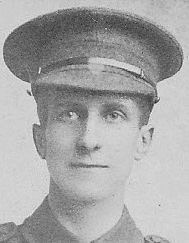Pte
George Frank Rich Mullins
Informatie over geboorte
|
Geboortedatum: 02/02/1891 |
|
Geboorteplaats: Bristol, Gloucestershire, Engeland, Verenigd Koninkrijk |
Algemene Informatie
|
Beroep: Klerk - Bediende |
Informatie legerdienst
|
Land: Engeland, Verenigd Koninkrijk |
|
Strijdmacht: British Expeditionary Force |
|
Rang: Private |
|
Service nummer: 202848 |
|
Dienstneming plaats: Cardiff, Glamorgan, Wales, Verenigd Koninkrijk |
|
Eenheden: — Oxfordshire & Buckinghamshire Light Infantry, 2/4th Bn. (Laatst gekende eenheid) |
Informatie over overlijden
|
Datum van overlijden: 10/09/1917 |
|
Plaats van overlijden: Hill 35, België |
|
Doodsoorzaak: Killed in action (K.I.A.) |
|
Leeftijd: 26 |
Gedenkplaats
|
Tyne Cot Memorial Paneel: 97 |
Onderscheidingen en medailles 2
|
British War Medal Medaille — 01/11/1920 |
|
Victory Medal Medaille — 01/11/1920 |
Points of interest 3
| #1 | Geboorteplaats | ||
| #2 | Dienstneming plaats | ||
| #3 | Plaats van overlijden (bij benadering) |
Mijn verhaal
Private George Frank Rich Mullins served in the Oxfordshire & Buckinghamshire Light Infantry, 2nd/4th Battalion, part of the 184th Brigade, of the 61st (2nd South Midland) Division.
The 61stDivision participated in the Third Battle of Ypres. On the 9th of September 1917 the Oxford and Bucks Light Infantry 2nd/4th Battalion took up positions in the frontline near Pommern Castle, where it relieved the Oxfordshire & Buckinghamshire Light Infantry 2nd/1st Battalion.
The following day the Battalion had to attack a German battery position on Hill 35. It was already the seventh British attempt to storm Hill 35. Previous attacks had all been in vain, as the insignificant ridge was well protected by a series of concrete pill-boxes and three major German strongpoints. The stronghold at Hill 35 was flanked by Gallipoli, a German stronghold behind the ridge and its sister position of Iberian.
After waiting almost an entire day cramped in their shell holes the men advanced at 4 p.m. behind a creeping barrage. The shrapnel barrage proved too weak. Many shells fell too short and the barrage was not able to smash the German strongpoints. The men struggled to advance rapidly over the utterly destroyed terrain and the German defenders had ample time to man their positions. Heavy machine-gun fire, coming from Iberian on the right and Aisne on the left, immediately enfiladed the ranks. The attack soon came to a standstill. Those who did not duck for cover were mowed down. The seventh attempt to capture Hill 35 had failed.
The men waited until the cover of darkness to withdraw to their jump-off line, leaving many dead behind on the slope of Hill 35. Sixteen men were killed and 38 men were wounded. The Battalion was relieved during the night and left the Ypres front after the futile battle at Hill 35. Private George Frank Rich Mullins was one of the men who was killed on the slope of Hill 35. His remains were never identified. George Frank Rich Mullins is remembered on the Tyne Cot Memorial.
The 61stDivision participated in the Third Battle of Ypres. On the 9th of September 1917 the Oxford and Bucks Light Infantry 2nd/4th Battalion took up positions in the frontline near Pommern Castle, where it relieved the Oxfordshire & Buckinghamshire Light Infantry 2nd/1st Battalion.
The following day the Battalion had to attack a German battery position on Hill 35. It was already the seventh British attempt to storm Hill 35. Previous attacks had all been in vain, as the insignificant ridge was well protected by a series of concrete pill-boxes and three major German strongpoints. The stronghold at Hill 35 was flanked by Gallipoli, a German stronghold behind the ridge and its sister position of Iberian.
After waiting almost an entire day cramped in their shell holes the men advanced at 4 p.m. behind a creeping barrage. The shrapnel barrage proved too weak. Many shells fell too short and the barrage was not able to smash the German strongpoints. The men struggled to advance rapidly over the utterly destroyed terrain and the German defenders had ample time to man their positions. Heavy machine-gun fire, coming from Iberian on the right and Aisne on the left, immediately enfiladed the ranks. The attack soon came to a standstill. Those who did not duck for cover were mowed down. The seventh attempt to capture Hill 35 had failed.
The men waited until the cover of darkness to withdraw to their jump-off line, leaving many dead behind on the slope of Hill 35. Sixteen men were killed and 38 men were wounded. The Battalion was relieved during the night and left the Ypres front after the futile battle at Hill 35. Private George Frank Rich Mullins was one of the men who was killed on the slope of Hill 35. His remains were never identified. George Frank Rich Mullins is remembered on the Tyne Cot Memorial.
Bronnen 2
|
2/4 Battalion Oxfordshire and Buckinghamshire Light Infantry , (The National Archives, KEW (TNA), WO 95/3067/1). https://discovery.nationalarchives.gov.uk/details/r/C14303 Verdere verwijzing |
|
Rose G.K., The Story of the 2/4th Oxfordshire and Buckingamshire Light Infantry, (Oxford, B.H. Blackwell, 1920), pg. 130-141. Gebruikte bronnen |
Meer informatie 3
|
Commonwealth War Graves Commission Database https://www.cwgc.org/find-records/find-war-dead/casualty-details/831725 |
|
Namenlijst (In Flanders Fields Museum) https://namenlijst.org/publicsearch/#/person/_id=c0a405b9-c18f-4b30-8807-00edaff1ccd1 |
|
Lives of the First World War (Imperial War Museum) https://livesofthefirstworldwar.iwm.org.uk/lifestory/7663209 |
